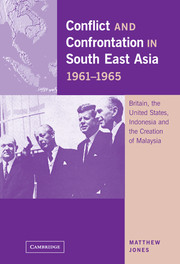 Conflict and Confrontation in South East Asia, 1961–1965
Conflict and Confrontation in South East Asia, 1961–1965 Published online by Cambridge University Press: 25 July 2009
During the late 1950s and early 1960s, both Britain and the United States were still trying to adjust and come to terms with the tumultuous changes brought to South East Asia by the effects of the Second World War. The dramatic events of 1941–2, when Japan, an Asian and non-white power, had confronted Western dominance in the region, had provided a powerful new spur to local nationalist and revolutionary feeling and helped to undermine previous perceptions of European omnipotence and superiority. As the struggle between Japan and her Occidental adversaries was played out, the states and societies of South East Asia found themselves afflicted by the direct effects of the fighting, a complete disruption of the pre-war social order, economic dislocation, occupation and the eventual return of the colonial powers in 1945 (the latter being seen by many as a second occupation). Moreover, the Japanese had brought with them an ideology of Asian liberation from Western imperialism that struck a chord throughout the whole area. By the end of the war, local resistance to Japan's own imperial and racial pretensions had also emerged in such areas as Indochina, Malaya and the Philippines. In the window of opportunity accorded by the sudden Japanese surrender in August 1945, nationalist leaders came forward to assert claims of independence and statehood, transforming the local scene for the returning and much weakened European powers, who despite all the signs that a reversion to pre-war patterns of control and domination was no longer tenable, sought to further exploit the economies of the region and rediscover the grandeur of an imperial past that had now run its course.
To save this book to your Kindle, first ensure no-reply@cambridge.org is added to your Approved Personal Document E-mail List under your Personal Document Settings on the Manage Your Content and Devices page of your Amazon account. Then enter the ‘name’ part of your Kindle email address below. Find out more about saving to your Kindle.
Note you can select to save to either the @free.kindle.com or @kindle.com variations. ‘@free.kindle.com’ emails are free but can only be saved to your device when it is connected to wi-fi. ‘@kindle.com’ emails can be delivered even when you are not connected to wi-fi, but note that service fees apply.
Find out more about the Kindle Personal Document Service.
To save content items to your account, please confirm that you agree to abide by our usage policies. If this is the first time you use this feature, you will be asked to authorise Cambridge Core to connect with your account. Find out more about saving content to Dropbox.
To save content items to your account, please confirm that you agree to abide by our usage policies. If this is the first time you use this feature, you will be asked to authorise Cambridge Core to connect with your account. Find out more about saving content to Google Drive.